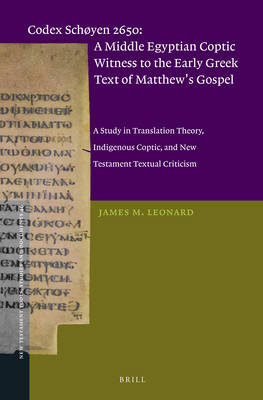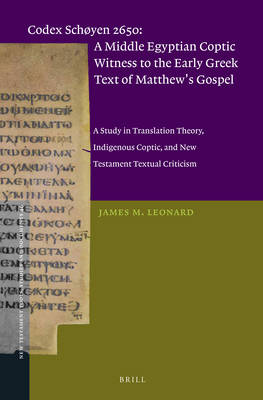
- Afhalen na 1 uur in een winkel met voorraad
- Gratis thuislevering in België vanaf € 30
- Ruim aanbod met 7 miljoen producten
- Afhalen na 1 uur in een winkel met voorraad
- Gratis thuislevering in België vanaf € 30
- Ruim aanbod met 7 miljoen producten
Zoeken
Codex Schøyen 2650: A Middle Egyptian Coptic Witness to the Early Greek Text of Matthew's Gospel
A Study in Translation Theory, Indigenous Coptic, and New Testament Textual Criticism
James M Leonard
€ 218,45
+ 436 punten
Omschrijving
In 2001, the exciting but enigmatic 4th century Coptic Matthew text, Codex Schøyen, was introduced as an alternative, non-canonical Matthew. In this book, James M. Leonard refutes these sensational claims through fresh methodological approaches and easily accessible analysis. Leonard reveals that the underlying Greek text is one of great quality, and that Codex Schøyen can contribute to the identification of the earliest attainable text--but only with due concern for translational interference. Leonard shows how Codex Schøyen's close alliance with Codices Vaticanus and Sinaiticus allows triangulation of the three to help identify an earlier text form which they mutually reflect, and how this impacts a dozen variant passages in Matthew.
Specificaties
Betrokkenen
- Auteur(s):
- Uitgeverij:
Inhoud
- Aantal bladzijden:
- 316
- Taal:
- Engels
- Reeks:
- Reeksnummer:
- nr. 46
Eigenschappen
- Productcode (EAN):
- 9789004257382
- Verschijningsdatum:
- 6/06/2014
- Uitvoering:
- Hardcover
- Formaat:
- Genaaid
- Afmetingen:
- 160 mm x 239 mm
- Gewicht:
- 612 g

Alleen bij Standaard Boekhandel
+ 436 punten op je klantenkaart van Standaard Boekhandel
Beoordelingen
We publiceren alleen reviews die voldoen aan de voorwaarden voor reviews. Bekijk onze voorwaarden voor reviews.











